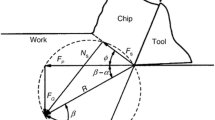Abstract
The increase in convenience and value of many industrial and household products due to their size and weight reduction over the years has triggered the rapid development of micromachining technologies. V-grooves have gained attention in micromachining due to their versatile use on a wide variety of products. To date, a double-flank axial cutting strategy involving a constant cutting depth set is commonly used in the fabrication of V-grooves. By contrast, the current study introduces a single-flank cutting strategy (SFCS) with two main implementations: constant chip thickness (CCT) and constant cutting area (CCA). The two implementations of the proposed SFCS were compared in terms of both experimental and numerical force results. The thorough comparison performed revealed advantages and disadvantages for both implementations in terms of cutting force magnitude, machining time, and surface quality obtained after a finishing pass. The results obtained revealed that a strong linear dependence exists between the area of material removed and the cutting force in the CCT implementation, whereas the CCA implementation is characterized by a quasi-constant cutting force magnitude owed to the constant area of material removed in each cutting pass. Moreover, while both implementations yielded surface quality within the optical surface quality range (Sa under 15 nm), the CCT variant is characterized by longer machining times and lower force levels, whereas the CCA implementation employs fully controllable cutting forces at preset levels. As such, the CCA implementation can be associated with stable cutting dynamics, predictable tool wear, and unanticipated tool breakage.


















Similar content being viewed by others
Availability of data and materials
Not applicable.
Code availability
Not applicable.
References
Walboomers XF, Jansen JA (2001) Cell and tissue behavior on micro-grooved surfaces. Odontology 89(1):0002–0011
Milliken N et al (2018) Enhanced bidirectional ultraprecise single point inverted cutting of right triangular prismatic retroreflectors. Precis Eng 52:158–169
Beranek MW, Hager HE, Chan EY (1999) Optical subassembly with a groove for aligning an optical device with an optical fiber. United States patent US 5,896,481.
Flucke C, Gläbe R, Brinksmeier E (2008) Diamond Micro Chiselling of Molding Inserts for Optical Micro Structures”. InProceedings of the 23rd Annual Meeting and 12th ICPE, Portland (pp. 92-95).
Suzuki H et al (2007) Precision cutting of aspherical ceramic molds with micro PCD milling tool. Annals of the CIRP 56(1):131–134
Wang S et al (2014) A study of the fabrication of v-groove structure in ultra-precision milling. Int J Comput Integr Manuf 27(11):986–996
Peng Y, Jiang T, Ehmann K (2014) Research on single-point diamond fly-grooving of brittle materials. The International Journal of Advanced Manufacturing Technology 75(9–12):1577–1586
Butler-Smith P, Axinte D, Daine M (2011) Ordered diamond micro-arrays for ultra-precision grinding — an evaluation in Ti–6Al–4V. Int J Mach Tools Manuf 51(1):54–66
Moriya T et al (2010) Creation of V-shaped microgrooves with flat-ends by 6-axis control ultraprecision machining. CIRP Ann Manuf Technol 59(1):61–66
Wang S et al (2018) Development of a precision grinding machine system for the fabrication of micro V-grooves array. The International Journal of Advanced Manufacturing Technology 97(5–8):2141–2150
Zhang S et al (2019) Advances in ultra-precision machining of micro-structured functional surfaces and their typical applications. Int J Mach Tools Manuf 142:16–41
Yan J et al (2010) Fabricating microgrooves with varied cross-sections by electrodischarge machining. The International Journal of Advanced Manufacturing Technology 50(9–12):991–1002
Haidong Z et al (2016) A study on ultrasonic elliptical vibration cutting of Inconel 718. Shock Vib 2016:3638574
Simpson J (1982) The effect of rotor fiber groove design on trash accumulation, end breakage, and yarn properties. Text Res J 52(1):52–59
Joao D et al (2020) Axial strategies for ultraprecise single point cutting of V-grooves. Precis Eng 66:10–20
Joao D et al (2019) Axial strategy for ultraprecise single point cutting of V-grooves Case 1: constant chip thickness. Procedia Manufacturing 34:440–445
Lee J-M et al (2010) Micro grooving simulation and optimization in the roughing stage. Int J Precis Eng Manuf 11(3):361–368
Liu X et al (2018) Burr formation mechanism of ultraprecision cutting for microgrooves on nickel phosphide in consideration of the diamond tool edge radius. The International Journal of Advanced Manufacturing Technology 94(9):3929–3935
Opoz TT, Chen X (2016) Chip formation mechanism using finite element simulation. Strojniški vestnik-J Mech Eng 62(11)
Steinberg D, Cochran S, Guinan M (1980) A constitutive model for metals applicable at high-strain rate. J Appl Phys 51(3):1498–1504
Akram S et al (2018) Numerical and experimental investigation of Johnson-Cook material models for aluminum (Al 6061–T6) alloy using orthogonal machining approach. Adv Mech Eng 10(9):1687814018797794
Markopoulos A, Manolakos D (2010) Finite element analysis of micromachining. J Manuf Technology Research 2(1–2):17–30
Ramezani M, Ripin ZM (2010) A friction model for dry contacts during metal-forming processes. The International Journal of Advanced Manufacturing Technology 51(1):93–102
Bourne KA (2010) Development of a high-speed high-precision micro-groove cutting process. University of Illinois at Urbana-Champaign 352
Acknowledgements
The work presented in this study is the result of the collaboration between Western University (London, Ontario) and the National Research Council of Canada (London, Ontario).
Funding
Partial financial support was provided by the Natural Sciences and Engineering Research Council (NSERC) of Canada.
Author information
Authors and Affiliations
Contributions
All authors have contributed equally to this work.
Corresponding author
Ethics declarations
Conflict of interest
The authors declare no competing interests.
Additional information
Publisher's Note
Springer Nature remains neutral with regard to jurisdictional claims in published maps and institutional affiliations.
Rights and permissions
About this article
Cite this article
Joao, D., Rangel, O., Milliken, N. et al. Single-flank machining strategy for ultraprecise single-point cutting of V-grooves. Int J Adv Manuf Technol 120, 4505–4523 (2022). https://doi.org/10.1007/s00170-022-08732-0
Received:
Accepted:
Published:
Issue Date:
DOI: https://doi.org/10.1007/s00170-022-08732-0




